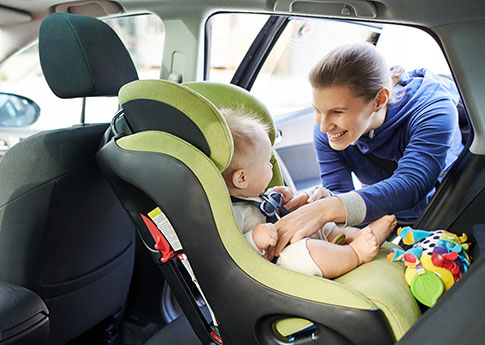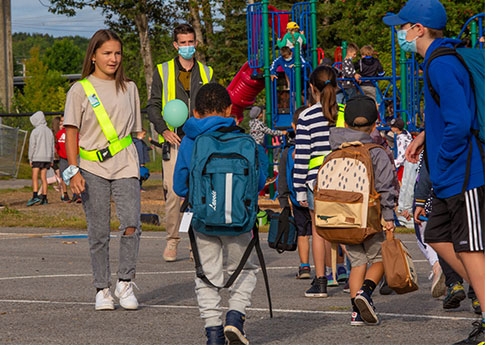Road safety at every age

Road safety is everybody’s business. But we all have different roles and responsibilities at different times in our lives. Read on for information, tips, and a few important reminders to keep you and others safe and to help do your part for road safety at every stage of life.
Road safety for babies and young children
Babies obviously can’t do much to ensure their own safety on the road—that’s their parents’ job. But children do need to learn as early as possible about the importance of keeping their seatbelt on, not throwing objects inside the car or out the window, not screaming, and waiting for the right moment to talk to the adults—in short, how to avoid being a distraction for the driver. All this comes with a lot of practice, patience, and good role models.
Car seats and booster seats

From the day they bring their newborn home and in the years that follow, parents have to put their children in the right car seat for their height and weight. Parents should consult the car seat manual for installation instructions and information on the proper direction (facing front or back) depending on the child’s age. The vehicle owner manual will also have important information. Société de l’assurance automobile du Québec (SAAQ) does not recommend the use of second-hand car seats, as they have a limited lifespan (between 6 and 12 years). It’s best to recycle children’s car seats once your kids have outgrown them.
Bicycle trailers and child bike seats
Bike seats come in several models (rear with or without support, front), as do bike trailers, including hybrids that can also be used as jogging strollers. Like car seats, bike seats must be suitable for the child’s weight, properly installed, and compatible with the bicycle.
Experts and the SAAQ recommend bike seats and trailers for children 12 months and older who are able to sit unassisted and whose necks are strong enough to support the weight of a bike helmet. This is a recommendation, not a law. But it’s essential for parents to exercise good judgment and caution at all times, as nobody is immune to accidents. Tip: Installing a mirror on your handlebars will allow you to keep an eye on your little passengers while maintaining your focus on the road.
Road safety awareness: It’s never too early to start!
Make it fun for children to learn road safety rules, since these lessons will need to be repeated over and over again, whether it’s about staying safe while walking, cycling, or just playing near the street. Children learn quickly and will often surprise you. Some may even choose to join their school safety patrol later on to help keep their peers safe, both on and off the school grounds.

Road safety for teens
Adolescence is a crucial period for road safety. For many people, this is when they start driving (it’s important to choose a good driving school) and learning more about the Highway Safety Code and what happens when you don’t follow the rules. That includes the dangers of using a cell phone behind the wheel (especially texting), as well as alcohol and drugs (cannabis and THC affect your driving).
Some young people wait to get their driver’s licence and instead choose to carpool with their friends. They need to learn how to say, “Not My Ride!” when their driver is not fit to drive because of drugs, alcohol, or fatigue.
Road safety for adults
As an adult driver, your greatest challenge behind the wheel is to remain vigilant despite your many years of driving and life experience. The risks of overconfidence are very real, particularly when it comes to impaired driving due to alcohol. Not only could you kill or injure someone, you could also face significant financial consequences.
Distractions like onboard computers, GPS, music, and eating or drinking are other dangers adults need to be especially careful about. The best way to reduce distracted driving is to minimize interaction with the onboard computer while behind the wheel. That’s why the CAA-Quebec Foundation developed the UPP method, which involves Understanding your system, Pairing your phone with it, and Programming the system before you leave.

Many adults have vision problems and therefore find it difficult to drive in the dark. If you are one of them, you’ll need to adapt and plan accordingly. And of course, it’s essential to keep your knowledge and skills up to date (a few hours of driver training can go a long way) to make sure you’re following the Highway Safety Code. A judge will never cancel a ticket if you plead ignorance—it just doesn’t work that way.
Road safety for seniors
Driving safely isn’t a matter of age. It’s a question of physical and cognitive ability. While some of the capacities needed for driving (vision, perception, reaction time, fitness) start to diminish as early as age 45 (in addition to the effects of certain medications), that doesn’t mean it’s time to hang up your keys. The important thing is to be aware of these changes and adjust accordingly.
What concrete measures can you take? In an effort to keep seniors behind the wheel as long as possible and as safely as possible, the CAA-Quebec Foundation has compiled tips and information in the Effects of Aging on Driving guide. The guide covers:
- Effects of aging on driving
- Possible vehicle adjustments (seat, steering wheel, seatbelt)
- Accessories that can make driving easier
- Choosing a more suitable vehicle equipped with driver assistance systems
- Preparing to drive
Driver refresher courses
The Highway Safety Code has undergone many changes in recent years. What’s more, a number of new road improvements have been introduced to improve safety. It may be a good idea to assess your driving skills (also possible with a professional) or to take a driving course for seniors. For certain, more stressful situations, like winter driving or roundabouts, more specific courses may be available.
Staying mobile without driving
And if the time comes when you have to give up driving, there are a number of ways to stay mobile, including other modes of transportation. Many drivers who were worried about losing their independence found there were benefits to hanging up their keys, like reducing stress, saving money, and meeting new people.
Road safety is everyone’s business. Through research, presentations, workshops, and outreach activities, the CAA-Quebec Foundation also helps save lives on the road.

Benefit from personalized advice
Do you have questions about gas-powered or electric vehicles, driving, or need recommendations to find an Approved Auto Repair Service?